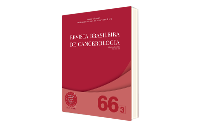Cutaneous Melanoma in a University Hospital, 2001-2016
DOI:
https://doi.org/10.32635/2176-9745.RBC.2020v66n3.911Keywords:
Melanoma/epidemiology, Skin Neoplasms/epidemiology, Skin DiseasesAbstract
Introduction: Melanoma is the main cause of death among primary skin neoplasms. The worldwide incidence has been increasing, however there is scarce national epidemiological information. Objective: Analyze the epidemiological and histopathological profile of cutaneous melanomas diagnosed at a university hospital in the last 16 years. Method: Historical series of cutaneous melanoma cases from review of charts and histopathological reports from 2001 to 2016. Results: The mean frequency over the years was 2.99 melanomas for every 1,000 new outpatient visits. The casuistry consisted of 224 cases of cutaneous melanomas in 211 patients, Caucasians (98.6%), women (55.9%), with mean age of 57.3 years. The mean time between onset of the lesion (time since the appearance of the lesion or since it began to change reported by the patient) and diagnosis was 4.8 years. The predominant tumor size was 0.5 to 2 cm, affecting the cephalic region in individuals older than 60 years and torso in those younger than 60 years. “Other melanomas” (34.8%) and superficial spreading melanoma (31.7%) were the predominant subtypes. Most of the cases had Breslow index ≤ 1 mm (70% of patients). The thinnest subtypes (≤ 1 mm) were superficial spreading melanoma and lentigo maligna. Nodular melanomas had intermediate Breslow (1 to 4 mm) or thick (≥ 4 mm) with high dissemination rate and lymph node metastasis. Conclusion: The frequency remained stable. Population below 60 years old had a higher prevalence. The most frequent subtypes were “other melanomas” and extensive superficial located mainly in the cephalic and torso regions.









